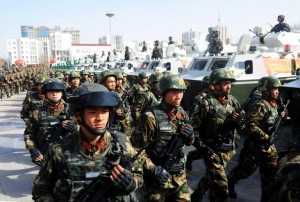The action-packed, prime-time segment on Chinese state-run television featured an elite police force storming a gated desert compound and sprinting toward a white, three-story house.
To some viewers, that house looked familiar.
The structure bore an uncanny resemblance to the compound in Pakistan where United States Navy SEALs killed Osama bin Laden in 2011. Like that house, this one had a wide, flat roof and small windows; the verandas and the outhouses were similar, and even the triangular yard was of the same proportions.
The news item, broadcast Friday on a China Central Television channel devoted to military affairs, did not mention bin Laden or point out the similarities to the compound in the Pakistani city of Abbottabad where he spent his last years in hiding. But an eagle-eyed fan of the People’s Liberation Army noticed, posting a screen shot of the replica on Weibo, the Chinese version of Twitter, along with several photos of the bin Laden compound for comparison.
“Imitating and then innovating is better than working on your own behind closed doors,” one Weibo user said in a comment on the post.
The CCTV segment was filmed in Xinjiang, the vast desert region of western China that has occasionally experienced ethnic unrest and attacks on the authorities. Many Uighurs, members of a Muslim, Turkic-speaking group that makes up the majority of Xinjiang’s population, resent what they consider Beijing’s heavy-handed rule.
China has rapidly expanded its military force in the region, pointing to reports that Uighurs have traveled to Iraq and Syria and are suspected of joining the Islamic State. A think tank based in Washington, New America, said last year that at least 114 Uighurs were believed to have joined the extremist group. But China has not produced evidence connecting Xinjiang’s occasional outbreaks of violent unrest in recent years to international terrorism.
Last month, armed antiterrorism forces held large rallies in several Xinjiang cities, including the capital, Urumqi. The news segment Friday on counterterrorism training in the region appeared to be a show of force of a different kind.
The central figure who leads the raid into the bin Laden-like house is Zhang Yue, leader of the Bayingolin special force squadron of the Xinjiang Armed Police Corps. In true propaganda style, the narrator endows Mr. Zhang with a rosy résumé, studded with brave deeds.
“After being enlisted for 13 years, he has risen from the ranks to the top of the elite special force,” the voice-over says. “It is the routine of this squadron to have intensive training in an unfamiliar environment, so they can calmly handle all kinds of urgent, difficult, dangerous and heavy tasks.”
Mr. Zhang, described by one of his subordinates as being “like a devil,” belonged to the Chinese team that performed in an international competition for special forces in Jordan in 2014.
Col. David S. Maxwell, associate director of the Center for Security Studies at Georgetown University, who watched the CCTV segment on YouTube, said there was little doubt that Mr. Zhang and his forces were copying American techniques.
“The movements, room-clearing techniques and shooting drills are all basic special operations techniques,” he said. “I did not see any advanced techniques such as explosive breaching, mechanical breaching — and something you do not see in propaganda films — failed breaches.”
Colonel Maxwell said it was important for counterterrorism forces to train to handle unexpected developments, like the Black Hawk helicopter crash during the bin Laden raid. “There is a big difference between demonstrating choreographed skills and being able to conduct combat operations in the fog and friction of real war when things go wrong, as they did for the assault force in Abbottabad,” he said.
(The compound in Abbottabad, Pakistan, where Osama bin Laden spent his last years in hiding until his death in 2011)
Li Wei, an antiterrorism expert at the China Institute of Contemporary International Relations, a government think tank in Beijing, said that training at the bin Laden-like compound was the next best thing to combat experience for China’s special forces.
“Even though China has built up a strong antiterrorism force, there are still few chances for them to be trained in actual combat, especially compared to the Americans who have conducted operations in the Middle East and elsewhere,” Mr. Li said. He said the terrorist threat in the southern part of Xinjiang, where the bin Laden replica was built, was “still grave.”
The special training in Xinjiang may suggest that China plans to deploy its antiterrorism forces further afield, a move that would have been unthinkable until recently, said Zhang Baohui, a professor of international affairs at Lingnan University in Hong Kong. “I have seen some reports that China may send its P.L.A. forces to Central Asian countries,” Mr. Zhang said.
A CCTV report last year quoted Yevgeniy Sysoyev, an antiterrorism official at the Shanghai Cooperation Organization, which includes China, Russia and four former Soviet republics, as saying that China had provided training, equipment and other assistance to Central Asian governments.
The CCTV segment on Friday was not the first to feature a replica of a well-known structure coming under assault from Chinese forces. In 2015, military forces were shown storming a fake version of the presidential palace in Taipei, capital of Taiwan, the self-governed island that Beijing says must eventually be reunited with China.
Ask me anything
Explore related questions






